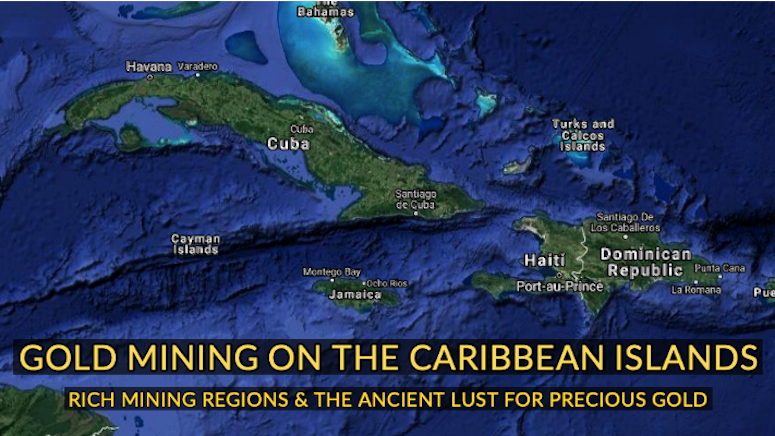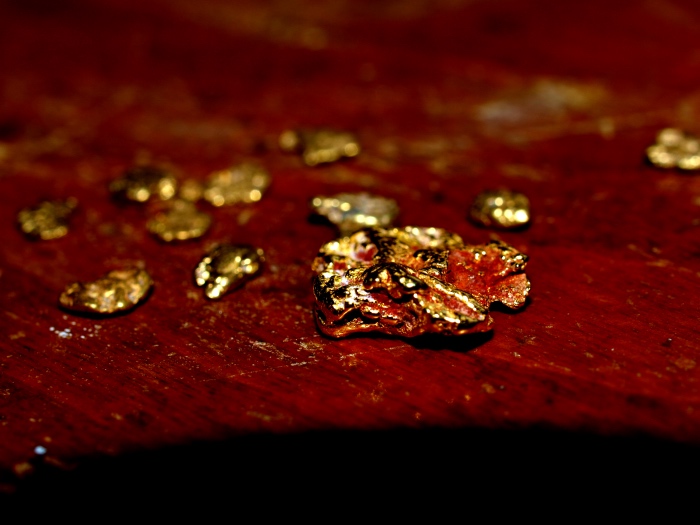
The Caribbean islands have long been worked for gold by their inhabitants. The history of gold mining on the islands began long before written records were available and continues to endure into modern times.
Pre-Columbian Gold
The pre-Columbian inhabitants of the Caribbean islands were primarily the Taínos (also known as Arawaks) and the Caribs. Though few gold artifacts have been found throughout Caribbean indiginous sites, it is known that the Taínos were aware of gold placer on the islands and wore it as small pieces of jewelry.
The Taínos often preferred a low-karat, purplish-colored gold referred to as “guanín.” It was an alloy of gold, silver and copper, likely originating from Cuba. But the Spanish were more interested in “caona”, the placer gold of a higher carat.
The Spaniard Arrival
Columbus had sought out information about the sources of the gold he saw the islanders wearing. He did not stumble upon anything of substance until December 1492, when his ship, the Santa Maria, was stranded on the banks of the island of Hispaniola (the island on which Haiti and the Dominican Republic are located currently).
Locals had approached the landed ship to trade small bits of gold in exchange for the ship crew’s brass hawks’ bells. The island leadership communicated to Columbus that there was a large supply of gold on the land mass and provided proof in the form of a lavish gold-inset mask.
Columbus had written to the Spanish King and Queen to notify them, rather too preemptively, that the island of Hispaniola was theirs and that multiple mines for gold and other minerals existed. The new spread quickly.
Placer Gold on the Islands
Despite finding on his next trip to Hispaniola that gold was primarily pulled from the streams and the island had not a single mine, the promise of wealth became a prime motivator for European explorations. A gold rush began across the Caribbean, focusing on Cuba and Hispaniola.
Between 1502-1509, the crown agreed to reduce their cut of all Hispaniola gold produced from 50 percent to 20 percent. As a result, entrepreneurs pushed forward and gold production reached its peak in 1509.
Retrieval of gold from the Caribbean islands persisted until more plentiful sources were found in Mexico around 1521. It was not until centuries later that a gold revival would come to the Caribbean, this time on Aruba.

Aruba
Back in 1499, when the Spanish first visited Aruba, they called it “Isla Inútil”, which means “Useless Island”. The Spaniards were clearly not impressed with Aruba’s seeming lack of gold, and they moved on to other islands in their search for treasure.
But in 1824, it was the island’s north shore that would eventually draw miners in with the simple story of a shepherd boy. Willem Rasmijn was retrieving one of his lost sheep, and he came upon a golden rock. When a second cache of gold was found in the area, it was confirmation enough to begin the Aruba Gold Rush.
Though gold remained a part of Aruba’s economy until 1916, the gold rush itself was brief as most of the accessible mineral sources were quickly mined-out. An estimated 3 million pounds of gold was pulled from the land.
The gold rush left its mark on Aruba. The Miralamar Mining Complex can still be seen in Arikok National Park, and the nineteenth-century Bushiribana Gold Mill ruins promise visitors the chance to find their own piece of gold.
Between 1987-1990, just a brief three years, Monte Carlo Gold Mines Ltd. of Canada was given permission from the Aruba government to mine gold on the island. Now Aruba focuses on tourism revolving around its gold rush history rather than developing the mining industry further.
Nature’s Rarest Treasures – Searching for Gold Nuggets
How Placer Gold is Deposited in Creeks & Rivers
Gold Mining on the Caribbean Islands Today
In 2012, the Pueblo Viejo mine opened its operations in the Sánchez Ramírez Province of the Dominican Republic, becoming one of most prolific gold mines in the world. It is also the second largest high-sulphidation gold deposit to be discovered.
Gold from the mine now makes up nearly 30 percent of the country’s exports, a total net value equal to 2 percent of the Dominican GDP. With plans to double the mine’s output in place, it’s safe to say that gold mining is alive and well in the Caribbean.
The regional manager of Acme Analytical (Laboratories) Guyana believes that gold in the Caribbean has been largely untapped. He notes that Haiti is known to be a source of high-grade gold and the Caribbean region as a whole is an opportunity for mining development.
Countries along the Caribbean coastline such as Suriname and Guyana are already becoming burgeoning sources of gold production, yet many of the Caribbean islands wait on the sidelines. As trust builds between investors and the governments in the region, more gold mining projects may emerge.
Next: Huge Gold Mines in Brazil’s Amazon Jungle
